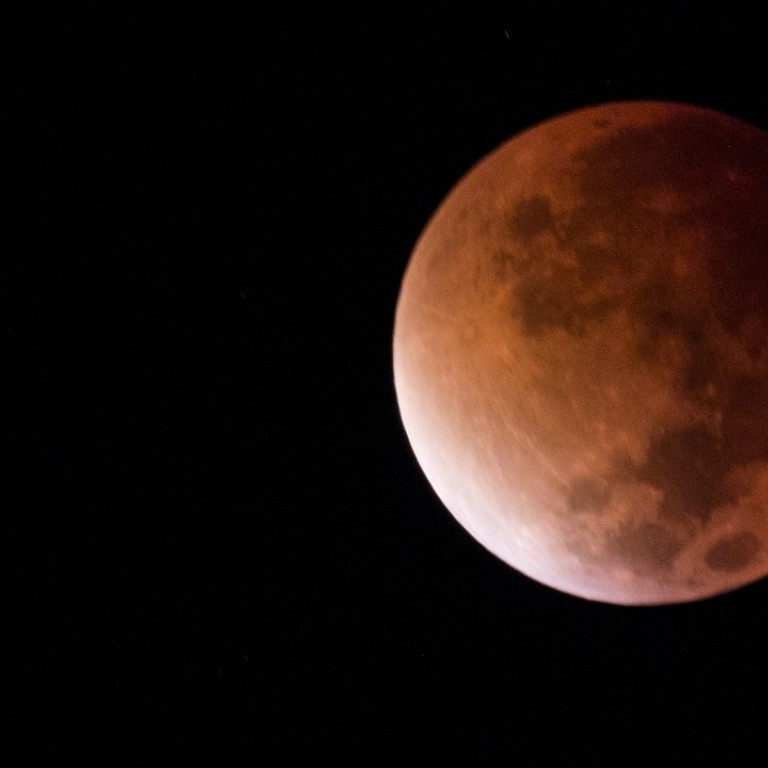
Supermoon total lunar eclipse: why Hong Kong is among best places to see it and where sky-gazers can get clearest view
The supermoon total lunar eclipse at the end of this month is a rare event not to be missed and Hongkongers are ideally placed to see the full incredible spectacle
On the night of Wednesday, January 31, Hong Kong will see the full moon turn pink, then deep orange, and back again as a total lunar eclipse occurs over the course of two hours.
The city is among a handful of the best-positioned places in the world to watch the event, which takes place two weeks before Lunar New Year.
8 of the best places for stargazing in Asia (and 5 sights Hongkongers can enjoy)
Since the full moon will be slightly closer to Earth than usual, it will also be a larger total lunar eclipse than most – an event called a supermoon.
A “total” lunar eclipse occurs when the Earth is directly between the sun and the moon and the whole of the moon is in the darkest part of Earth’s shadow. A regular lunar eclipse – which happens a few times a year – occurs when the moon is in the outer, lighter part of Earth’s shadow. Both can only occur during the monthly full moon when the three bodies are in the same order but are indirectly aligned.
On average, we see a total lunar eclipse once every three to four years in Asia
Unfortunately for people in the UK and Europe, the event will take place during their daylight hours. It will, however, be visible as an early morning spectacle in western US. Hong Kong and East Asia are particularly well positioned as the eclipse will take place in the evening.
On January 31 in Hong Kong, the moon will enter Earth’s outer shadow – the penumbra – at 6.51pm and its brightness will dim considerably. At 7.48pm the moon will begin to enter the darkest part of the shadow – the umbra – and will start to turn pink as sunlight is bent through the Earth’s atmosphere and projected on to the moon, just as during a sunset.
An hour later, at 8.51pm, the moon will be in full lunar eclipse – “totality” – and be a deep orange. The eclipse “peaks” at 9.20pm, after which the spectacle goes into reverse, the full moon losing its deep colour and gradually becomingly glaringly bright towards midnight.

Hawaii in the Pacific will actually get the best view, since the entire eclipse will be visible high in the sky long before the moon sets and the sun rises – meaning a better chance of avoiding cloud near the horizon. Totality in Hawaii starts at 2.51am Hawaii-Aleutian Standard Time, and ends at 4.07am.
Another great place to watch from will be Australia, where the eclipse happens during the middle of the night so it is high in the sky. In Sydney, totality occurs at 11.51pm Australian Eastern Daylight Time, and ends at 1.07am on February 1.
“On average, we see a total lunar eclipse once every three to four years in Asia,” says Tommy Tse Tat-fung, a jeweller and eclipse-chaser from Hong Kong who has seen nine total solar eclipses and eight total lunar eclipses.
Although the upcoming eclipse can be viewed with the naked eye from anywhere in Hong Kong, Tse has some advice on getting the best view. “Any part of Hong Kong facing east with a clear view should be fine, as the lunar eclipse starts not so long after nightfall,” he says.
Supermoon over Hong Kong inspires photographers to capture lunar marvel
Experienced sky-watchers recommend being well prepared for the event. “Know the area where you will be watching so that you do not stumble in the dark,” says Eddie Mahoney, Nasa ambassador and director of astronomy at the Hyatt Regency Maui in Hawaii, which will get a great view of the eclipsed moon. “Have your supplies ready, like hot cocoa, snacks, layers of clothing and any photographic gear you plan to use – and comfortable seating.”
Mahoney adds that the amount of volcanic dust in the Earth’s stratosphere affects the colour of the eclipsed moon, and that conditions should produce a very bright red-looking moon.
Victoria Harbour is likely to prove a popular place to observe the event in Hong Kong, with key locations including the Kai Tak Cruise Terminal Park, and promenades in Tsim Sha Tsui, Hung Hom, Central, Quarry Bay and Tai Po.
From 7pm to 11pm, the Hong Kong Space Museum, together with local astronomy organisations, will host “Night of Total Lunar Eclipse”. This will see them set up telescopes at the Central and Western District Promenade (Central Section), Kowloon Park Piazza, and Sha Tin Park Main Plaza to help the public enjoy the eclipse.
As with all sky-gazing events, getting a good view of this total lunar eclipse is dependent on clear skies. While, at the time of writing, clouds are forecast for Hong Kong, all it takes is a small break in the cover to get a good view, so it is still worth planning an evening near the open views of the harbour.
In pictures: Hong Kong photographers show how to shoot night skies over city
The best equipment with which to view the eclipse is a pair of binoculars, Tse says. “Naked-eye observation is fine too, but it is much better with some magnification.” If you do have access to a telescope, Tse advises using one with a focal length of over 1,000mm but under 2,000mm for studying the moon close up.

